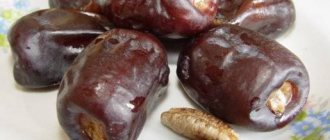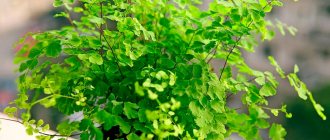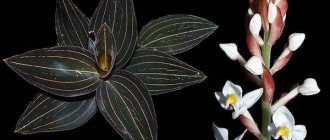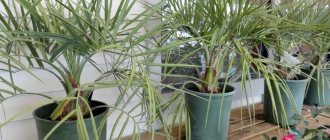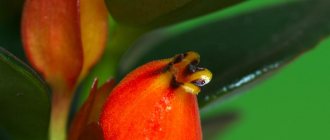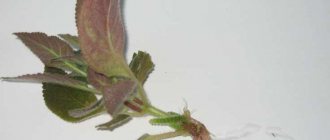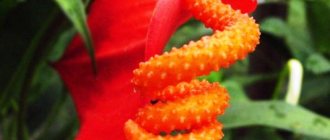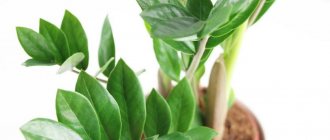Content
- Description
- Growing conditions Relation to moisture
- Temperature
- Chamerops in the garden in winter
- Lighting
- By division
- Watering
dan.kristiansen / Flickr.com
Unpretentious, hardy, quite compact and fluffy palm tree . Suitable for both indoor and garden conditions in the south of the Middle Zone and the Black Sea region.
The topic will be important to palm lovers, gardeners and collectors who own small summer cottages and want to create exotic gardens .
Krzysztof Ziarnek / Personal archive
False palms as an alternative - top 5 most famous
If for one reason or another it is difficult to arrange a real palm tree in your apartment, you can get a fake one. In nature, there are enough representatives of the flora that are externally similar to the “principles of the plant world”, but belong to other families. The five most common false palms include:
Dracaena
Dracaena bordata (D marginata) from the asparagus family is a frequent “inhabitant” of apartments and offices and is valued for its ability to purify the air from harmful xylene and formaldehyde vapors. The plant is characterized by a straight, unbranched stem, the upper part of which is crowned with a cap of narrow, straight leaves with a picturesque border.
IN THE PHOTO: A miniature palm depicts Dracaena bordata.
A low-maintenance, fragrant dracaena, it is distinguished by a rosette of long, curved green or variegated leaves.
IN THE PHOTO: In nature, fragrant dracaena flowers exude a wonderful aroma; flowering indoors is very rare.
Dragon Dracaena (D draco) has bluish-green leathery leaves clustered in large clusters at the top of the trunk. Fake palm trees grow slowly.
IN THE PHOTO: Over the course of a year, the growth of the Dracaena dragon increases by only 10 cm.
Yucca
The very name Yucca Giant (Y gigantea) suggests that this indoor false palm is suitable for decorating premises with high ceilings: a restaurant or a shopping center.
Pictured: Is Yucca as gigantic as a piece of furniture in a music studio? Why not.
Yucca filamentosa (Y filamentosa) is practically stemless, but its numerous linear-lanceolate leaves diverging to the sides resemble the crown of a palm tree. An additional decoration is provided by thin threads hanging along the edges of the foliage.
IN THE PHOTO: The variegated varieties of filamentous yucca look especially impressive.
Cordyline
Southern Cordyline (C australis) from the Agave family is a frequent guest in official establishments, similar in appearance to Dracaena.
In the PHOTO: A light stripe runs along the central part of the leaves of the southern Cordyline; red-leaved varieties are also present.
Zamia
The expanded pinnate leaves of Zamia coarse (Z furfuracea) are exactly the same as those of the palm tree. For this plant it received its second name “Cardboard Palm”.
IN THE PHOTO: Indoor zamia coarse usually grows no more than a meter in height.
Zamia broadleaf (Z muricata) is a low false palm with 2-4 long pinnate leaves on a very short stem.
In the photo: Zamia latifolia looks more like a fern than a palm tree.
Dieffenbachia
Despite the poisonous milky juice, the beautiful Dieffenbachia (D amoena) is grown indoors by almost any large hobbyist. As the stem grows, the large leaves at the bottom gradually fall off, and the plant conditionally becomes palm-shaped.
IN THE PHOTO: Dieffenbachia is a cutie, quite shade-tolerant, and tolerates dry indoor air well.
Description
- Chamaerops humilis is a true fan-shaped bushy palm with many trunks, high (in cultivation usually up to 3 m, at home up to 1.5 m).
- Fan leaves consist of 21-29 rays (rarely up to 35), dissected to the petiole, with each ray also cut in half almost to the middle of the length.
- blade is the petiole is the same length .
- in the crown , and on each trunk , of which there can be more than 10. All this makes the crown of Hamerops very fluffy.
Forest and Kim Starr / Personal archive
New trunks are formed from dormant buds at the bottom of the main trunk and on the roots, bending and touching the ground, they form their own roots. Thus, the bush can grow over tens of square meters, filling the space with itself, but this growth occurs very slowly , over decades.
By the way, in design , heaped, compact, multi-trunked chamerops bushes look much better than single or scattered trunks of this palm tree.
- The trunks are covered in a coat of reddish hairs (like trachycarpus).
- The leaves are hard, the leaf rays are straight, whitish on the underside.
- There is a variety of chamerops with silver-blue leaves (var. argentea), adapted to a drier and hotter climate
MPF / Personal archive
- When they die, the leaves dry out and, hanging, stay on the palm tree for another couple of years.
- The leaf petioles are equipped with hooked spines .
- The flowers are small, yellow-orange, unisexual or bisexual, forming cluster-shaped inflorescences. blooms in May-June.
- The fruits are oval drupes of orange-burgundy color. The seed is 5-7 mm, densely covered with hairs.
carmona rodriguez.cc / Flickr.com
Bathyporeia / Flickr.com
Hamerops
A genus of fan palms, represented in nature by only one species - Hamerops squat. This is a multi-stemmed, low-growing tree with a fluffy crown of large leaves with petioles covered with thorns. Under natural conditions, it reaches a height of 4-6 m. It is an unpretentious palm tree (fan palm); caring for it at home will not cause any particular difficulties.
In apartment conditions, Hamerops requires a temperature of 23-25°C in summer (it is best to take it out into the open air) and half as much in winter. During the period of active growth, watering is plentiful (with soft water) with periodic fertilizing with mineral fertilizers. Transplant only when necessary. Reproduction is not only by seed, but also vegetative - by shoots from the root.
Growing conditions
It is the only species of its genus and the only palm with a native range in mainland Europe, making Chamaerops one of the hardiest palm species in the world. In terms of its endurance, Hamerops is one of the top ten among palm trees.
Katja Schulz / Flickr.com
Relation to moisture
- It grows in the arid mountainous regions of Spain, North Africa and the western islands of the Mediterranean Sea.
- This is a very drought-resistant species that can tolerate drying out of the earthen clod for a week, retaining the necessary moisture in the trunk.
- Hamerops easily tolerates dry air in apartments and midday direct sun in the garden. Although better humid air .
Diotime/Flickr.com
Temperature
- The optimal summer temperature is +23-28 °C, but the plant successfully tolerates cold snaps and heat up to +40 °C.
- Optimal winter mode - +1-15 °C; Such conditions are necessary for wintering a palm tree indoors. Having accumulated strength during the rest period, in the summer the chamerops will be able to produce 2-3 leaves per month.
Chamerops in the garden in winter
- In winter, the palm tree can withstand for a short time and, even if it freezes to the ground, it always recovers from roots and dormant buds.
dan.kristiansen / Flickr.com
- It is important to prevent the soil from freezing and becoming excessively dry in winter.
- When drops to -8 °C, it is necessary to turn on the garland and heat the palm tree all night and morning.
- If the frost of -5-7 °C has lasted for 2-3 days, you also need to turn on the garland for 10-15 hours.
Lighting
- Adult chamaerops develop better in good bright light , and young animals develop better in partial shade , with direct sunlight.
- At home, a palm tree is placed near south window.
- is turned every 2 weeks from mid-May to mid-September.
Maja Dumat / Flickr.com
Benefits of decorating the interior with palm trees
Appearance is the main quality of a decorative palm. It is characterized by a variety of sizes and shapes. These plants come in both fast-growing and slow-growing varieties. The slow maturation rate allows you to grow a large palm indoors for some time and, before it reaches normal size for its natural environment, plant it elsewhere.
The speed of development also depends on care and the amount of sunlight received. Each individual subspecies has one or another ability, which makes the choice easier for those wishing to purchase this plant.
You can choose a beautiful and unpretentious palm tree: smooth or prickly, fast-growing if you need a large plant in a short time, or slow-growing if the long-term presence of the palm inside is a priority. Some species of dwarfs are raised by humans.
How to grow
is grown from seeds and by dividing the bush.
By division
- Cut off the medium-sized lateral root shoots with a knife and sprinkle the cuts with charcoal (on the mother plant too).
- take a long time to take root, 3-6 months, in the same soil as for sowing seeds.
Sowing seeds
Omar hoftun / Personal archive
- Seeds without cold stratification are soaked in warm water (+35-45 °C) for 2-3 hours, changing the water to warmer water every 30 minutes. Do not soak the seeds for several days!
- Sow the seeds in March in separate pots to a depth of 1 cm in a mixture of peat, sand and baking powder (perlite, vermiculite, etc.) in proportions 1:1:1.
- Drainage is needed at the bottom of the container (expanded clay, coal, pebbles).
- Shoots appear at a temperature of +25-30 °C within 1-2 months.
Tim Martin / Personal archive
pots for sowing, since Hamerops does not like transplants . It will grow in such a container for about 5 years, after which the palm tree, after preliminary hardening, can be transplanted into the garden.
Often this palm tree is grown as a permanent tub crop , taking it outside from April-May to September-November.
Alwyn Ladell / Flickr.com
Propagation of Hamerops palm by lateral shoots
Adult specimens of Hamerops form lateral processes. They can be used for reproduction. The shoots are separated during a planned transplant. In this case, it is necessary to monitor the degree of development of their root system. It is very difficult for specimens with weak roots to take root and therefore in most cases they die.
Under normal conditions, Hamerops produces very few lateral shoots. To stimulate their formation, cover the surface of the soil in the pot with a layer of sphagnum moss. In conditions of constantly high humidity, dormant buds begin to awaken at the base of the palm tree.
After separation, the shoots are planted in a mixture of perlite and peat. Loose soil substrate promotes the development of the root system. As soon as the plants begin to grow, they begin to be fed with complex mineral fertilizer.
As the roots develop, young palm trees are carefully transferred into larger containers. In the 2-3rd year of cultivation, clay begins to be added to the loose soil mixture. If this is not possible, the plants are transplanted into a ready-made industrial substrate for growing palm trees.
Landing Features
- Sometimes they write that sawdust . This cannot , since sawdust and shavings are very moisture-intensive, retain water for a long time and rot, infecting the palm tree.
- Also, when transplanting into open ground (April-June), you should not add excess manure , since it is an alkaline medium and can excessively increase the soil pH, which should be 6-7.
- Drainage must be poured into the planting hole , and 1 part of local garden soil is added
- When planting, it is important not to bury the seedling, but even to slightly raise the root collar above the general ground level (by 1-2 cm).
Forest and Kim Starr / Flickr.com
Popular varieties of domestic palms
Indoor plants - palm trees - are tropical inhabitants, but with proper care they feel great in ordinary apartments. We offer you the opportunity to familiarize yourself with the varieties of indoor palm trees: names and photos.
Areca
Areca is a plant with thin cylinders that protrude from a tubular base. The leaves are pinnately dissected. The inflorescences are shaped like panicles, with male staminate flowers at the top and female pistillate flowers at the bottom.
Areca produces fruit with fibrous berries from which the seeds are extracted.
Brachea
In some sources, this plant is also called braja, but in our country this spelling is becoming less and less common. Although it should be considered correct, since the species is named after the famous astronomer Tycho Brahe. The height of trees can reach 12 and even 15 m. The trunk of this type of ornamental plant is bare below. The foliage resembles rounded fans, with deep dissection into segments.
The inflorescences of this culture resemble a complex panicle. Their length reaches 5 m. The petioles are either smooth or pointed. The yellow-green flowers are collected in groups of 3. The brachea fruit has the shape of an egg or a ball.
They always have a fleshy shell. In nature, this plant inhabits Guadeloupe, the arid mountainous regions of Mexico and other Central American countries.
Bhutia
This species is also named after a person, but this time a Scottish nobleman. Butia capitata is a prominent representative of the palm family; this genus includes about 20 species. Its natural habitat is various countries in South America. The leaves always have a feathery structure, which distinguishes them. The height of the palm can reach 6 m with a trunk circumference of up to 50 cm.
bamboo palm
An elegant plant accustomed to the humid, warm climate of Mexico, it does surprisingly well at home. If you are a beginner gardener, this palm tree will be a great choice for you.
The single stem of the plant is decorated with an elegant, feathery top of the leaves. A decorative indoor palm tree will perfectly decorate any room, be it a bedroom or an office.
In addition, the plant is completely unpretentious. All a bamboo palm tree needs is moderate light, regular watering and warmth. But keep in mind that it cannot be stored in dry conditions. In fact, in this case it is almost always attacked by mites or snails.
Washingtonia
Washingtonia has a filamentous stem (W filifera) that is reddish. The leaves sit on long petioles, dissected into narrow segments. Thin, named fibers hang from the leaf blades.
IN THE PHOTO: Washingtonia is a thread peddler.
Washingtonia powerful (W robusta) with large fan-shaped leaves. Rich green glossy foliage. Old leaves, dying, form a compact seal on the stem, which tapers upward.
IN PHOTO: Washingtonia is strong.
Giophorba
The palm is distinguished by the unusual shape of the barrel in the shape of a vase. The surface of the trunk is smooth, thickened in the middle. The narrow part of the trunk can reach 15 cm in diameter, and the wide part - 40 cm. The height of the tree does not exceed 1.5 m.
The foliage is bright green, fan-shaped, feathered. It consists of 30-40 pairs of leaves, shaped like feathers. Their length does not exceed 40 cm.
Gouveia
These plants (sometimes called jovea) are in great demand among gardeners. They began to be cultivated indoors in Victorian England. FYI: You can only find Govea in the wild on Australia's Lord Howe Island.
Both species of this genus grow up to 3-5 m in indoor conditions, in this case they often stop at a lower figure.
Important features of culture can be considered:
- a large number of upper stems;
- extremely slow growth (up to 3 leaf blades per year);
- ease of growth;
- the ability to achieve a beautiful appearance only with careful care.
Rapis tall
High rape rates do well at home. It can grow up to three meters in height and has many trunks very similar to bamboo. Their diameter does not exceed 3-4 cm, they are covered with mesh fibers. The stems are crowned with dark green fan-shaped leaves 27-32 cm long with a glossy surface. The veins run along the entire length of the leaf, cutting the blade into 5-7 lobes.
Rapis loves ventilation and bright lighting, but without direct sunlight, otherwise burns may occur on the leaves. In winter, the palm tree should be kept in a poorly heated room with a temperature of 10-16 degrees Celsius. The plant does not tolerate drought and excessive humidity, so watering should be moderate. In summer it will be enough to water the soil once every three days, and in winter - once every ten days.
Ropalostylis
A popular representative of feathered species of ornamental palms. Ropalostilis grows naturally in New Zealand. Unlike most of his comrades, he needs careful attention and care.
The stem of Ropalostilis is covered with circular scars left by dead leaves. It has drooping cuttings with light green leaves. And in the trunk there is a protrusion that resembles a leg. During flowering, it looks like bird feathers - a very mesmerizing sight.
Thanks to the close distance between the leaves, this palm fits perfectly into the interior of small rooms. But keep in mind: Ropalostilis should not be touched often, otherwise it will die. But you should feed and water your palm more often.
The most common variety of Rhopalostylis is the Bauer tree.
Trachycarpus fortunea
Trachikarpus Fortune is the most winter-hardy palm, able to withstand temperatures as low as 10 degrees below zero. In indoor conditions it grows no higher than 2.5 meters, has oblong, rounded leaves reaching a diameter of 0.6-0.8 meters. They are found on long, often pointed petioles. The leaves are divided into segments; in some species the dissection occurs to the base.
Trachycarpus Fortune grows well in partial shade, as well as in bright, but diffused light. If yellow spots appear on the leaves of a palm tree in summer, it means that the sun's rays are falling on it. The plant is highly drought-resistant; it is necessary to moisten the soil only after the soil has dried by 20-30 mm.
Dypsis
The yellowish dipsis (D lutescens), with many bamboo stems like the domestic palm, is grown all over the world. The long, curved leaves are divided into hard, yellowish-green lobes.
IN THE PHOTO: Dipsis yellowish.
Dipsis decarie (D decaryi) is better known as triangle palm. Leaves on brown stems grow on opposite sides of the stem. The gills of the leaves are covered with a whitish coating.
IN THE PHOTO: Dipsis Decari.
Caryota
Tender carrion (C mitis) is a multi-stemmed plant with distinctive foliage. The wide, serrated blades resemble fins. It grows slowly, but for domestic palms this is more of an advantage than a disadvantage.
IN THE PHOTO: Dear Kariota.
Caryota (C urens) has only one stem. The dark green “ragged” leaves are triangular in shape. The owners are unlikely to be able to verify the unique taste of the fruit. Like other indoor palms in cultivation, it does not bloom or bear fruit.
In the photo: Kariota on fire.
Latania
Latania loddigesi (L loddigesi) is the only plant of this genus that has come into cultivation. The gray-green leaves are collected in a bunch, sitting on long reddish-brown petioles with thin but very sharp spines.
PHOTO: Loddiges patch.
Likyala
This is a dwarf palm. In appearance, this flower bears little resemblance to a palm tree. In nature, the height of the plant does not exceed 3 m. Large Likuala is grown by flower growers. It features beautiful folded leaves. The leaf blades are round, bright green, fan-like. The width of the leaves of an adult plant is up to 1 m.
The leaves of this variety are used in the production of hats.
Useful reading: Croton is a capricious beauty with extraordinary foliage.
Has a thin trunk. The fruits are large and hang in clusters. When grown indoors there is virtually no color.
Liviston
This type has gained popularity among the creators of living room interiors. Liviston will please the eye if the following measures are observed: good watering, sufficient lighting, high humidity, a warm room, spraying and drying the leaves.
Sabal
A small plant native to the subtropics of the United States. To care for it, you must follow all general care recommendations.
Trachycarpus
Very beautiful, so ideal for decorating a room. Its peculiarity is its fragrant yellow flowers that form inflorescences. Trachycarpus feels great when planted in open ground, but the temperature should be at least 5-7 ° C.
Date palm
An unusual tropical plant that thrives at home. The plant will require plenty of watering and regular spraying of the leaves, especially in the hot season.
Howea Belmora
Another popular decorative palm tree for the home. In the photo you see an adult specimen with large enlarged leaves. And this palm tree looks even more luxurious in real life! Rest assured, it successfully adapts to any environment.
The main condition for the development of Howey Belmora is regular and abundant soil moisture. It is also very important for her to be warm and light, which should always be in abundance. By paying attention to the plant and spraying it regularly, you will get a flawless palm tree that will decorate your home.
Hamedorea gracilis
Dwarf chamedorea graceful belongs to the palm family and has numerous densely arranged thin stems. It has a beautiful appearance and unpretentious character, is resistant to many pests, can grow in partial shade and withstand short droughts.
Erect stems reach a height of 1.5-2 m, their diameter is about 2-3 cm. Green pinnate leaves are formed on each trunk, consisting of 8-14 long narrow lanceolate plates and with grooved or rounded petioles.
Graceful Hamedorea grows very slowly; only 1-2 new leaves are formed on it per year. To make your home bush lush, several palm shoots are planted in one pot.
Hamedorea will grow well in a room with sufficient lighting; it needs to be watered only when the top layer of soil has dried well. It should not be placed near heating devices, as they generate dry air, which is harmful to the palm.
Chrysalidocarpus
Chrysalidocarpus is an ornamental palm that has several species and can be single- or multi-stemmed. It regulates indoor humidity well, grows up to two meters indoors, but rarely produces flowers.
It develops very slowly, growing by an average of 25 cm per year, the width of the palm grows faster due to the appearance of new stems. They can be smooth or hairy and have deep green leaves with smooth or pointed edges. Each branch has 40-60 pairs of long narrow leaves.
The palm tree loves bright light and can withstand direct sunlight, but also easily tolerates being kept in partial shade. Chrysalidocarpus needs regular and moderate watering, with emphasis on drying the top layer of soil.
Hamedorea
A very popular species among indoor plants. Simple breeding and simple maintenance will not be a problem.
Hamerops
It will grow very slowly, but unpretentiously. In ideal conditions it can reach 5 m in height. Gamerops loves loose soil, moderate regular watering, sunlight, and periodically requires replanting.
Basic care
Watering
- Water the palm tree at home once a week; in winter, once a month is enough if kept cool.
- In open ground, you don’t need to water at all, only during a prolonged period of drought - once a week.
- Brown spots on the leaves are a signal of waterlogging of the soil, which Hamerops categorically cannot tolerate.
Spraying
- Spray the chamerops as rarely as possible so as not to over-moisten the growing point, otherwise the palm tree will rot.
- In the garden, during drought and hot weather, you can sprinkle the crown with warm water approximately once a week.
- In room conditions, dust from the leaves is wiped with a damp, clean sponge. To prevent infections, hydrogen peroxide (1:10) can be added to the sponge water.
Scott Zona / Flickr.com
Feeding
- The palm tree in the garden , including when grown in containers, is fed with complex granular fertilizers 2-3 times per season.
- In indoor conditions, they are fed, like most ornamental foliage plants, perhaps in a lower concentration, from spring until the end of summer, once every 2-3 weeks.
Preparing for winter
In October, the leaves of the garden chamerops are collected in a bunch, protecting the growing point from rain.
Young specimens
- In November, a foam box is installed . First, the entire palm is wrapped with agrofibre in 3-4 layers.
- is attached to the plant , and the space in the box and the outside circle around the trunk are covered with mulch (straw, cereal husks).
Mature plants
- Mature palm trees are wrapped with burlap, then with a garland, and on top with agrofibre. And is heavily mulched . Then, even if the main trunk freezes to the ground, the chamerops will grow from dormant buds.
Dr. Nasser Halaweh / Flickr.com
Diseases, pests and problems
- Root rot can develop due to overwatering in cool conditions. Damaged roots are removed from the plant and transferred to fresh, moderately moist soil.
- Spider mites, on the contrary, are a result of insufficient watering and low air humidity. To combat it, acaricides are used, the water balance is restored to normal, the leaves are washed and sprayed.
- Scale insects manifest themselves as tubercles of 2-5 mm on all parts of the plant and a sticky coating on the leaves. Destroyed by intestinal drugs.
- Mealbug colonies hide in the axils of leaves and shoots. Methods of combating the same as with scale insects.
- Whiteflies are small flies that have chosen the back of the leaves. Insecticides are used.
- Drying leaves: insufficient air humidity.
- The leaves have turned yellow: insufficient watering.
- Spots on leaves of brown or brown color:
Chamerops is great both in a city apartment and in a winter garden. In summer you can take it out onto the veranda or outside, where it will show itself in all its glory.
With proper care, this northernmost palm tree will not only delight the owner with its lush crown, the width of which can be greater than the length of the trunk. It will purify the air, surround itself with a special microclimate, be a reminder of a vacation in Mediterranean Europe, or create a friendly atmosphere in the workplace.
Possible difficulties
- In winter, in a dry, warm room, chamerops can be attacked by spider mites .
- In the garden, when the plant’s immunity decreases due to high soil moisture and cold weather, the palm tree can be attacked by scale insects, mealybugs , and fungal diseases.
- Pests are eliminated insecticides (Aktellik, etc.).
- In case of fungal diseases, it is better to replant chamerops in new soil, in a drier place, with a thicker layer of drainage, closer to the southern wall of the house, treating it with fungicides. For the palm tree is a very beautiful, exotic and valuable plant to lose.
So, if you are creating a subtropical landscape in a temperate climate in your garden, selecting the hardiest types of palm trees, and want to create a luxurious landscape design with a resort microclimate, plant Hamerops squat . Combined with a small pond, it will remind you of warm Mediterranean beaches.
Discuss the video
Classification and types of domestic palm trees
The Palm family contains more than 200 genera and almost 3,500 species. Among the most famous “wild” representatives are Coconut, Bismarckia, Sabal, Roistunia, Date, Eleys, Mauritius, Sabal, etc.
Among the cultivated houses, one should note Jovea, Washingtonia, Areca, Livistona, Date, Tsikas, Hamedorea, etc.
Palm trees can be classified by leaf type. The leaf blades are fan-shaped and pinnate. In addition, plants of this family are conventionally divided into tropical and subtropical. The subtropics are considered more hardy. They are better adapted to home conditions and tolerate wintering well.
Cirrus
One of the features, as you probably guessed, is the presence of various leaves that form a kind of crown. The density and appearance of the leaves are different; they can be either soft or straight and arched, with a rigid structure.
Fan
fan palm
The large leaves are divided in shape into segments that fan out from the base of the leaf blade. The petioles are long, with spines.
Reed
reed palm
This group of plants has thin stems reminiscent of bamboo shoots with a height of 1 m or more. They are suitable for spacious rooms.
Hamedorea Seifrizii and Chamaedorea Erumpens have dark green leaves, only in the former they are narrow, in the latter they are wide. Their height can reach 2-3 m.
Choosing a palm tree for home cultivation
You should not buy a palm from a catalog, as this will not allow you to fully familiarize yourself with the condition of the copy. In order for the plant to bring joy for as long as possible, or at least not to infect its relatives with flower ailments, it is better to buy it in a specialized store or nursery.
When choosing, you need to pay attention to the condition of the flower. The following signs should alert you:
- completely or partially dried leaves;
- presence of an unpleasant musty odor;
- the plant is too elongated (usually due to a lack of sunlight);
- stickiness of leaves or growths on them is a sign of disease;
- abnormal leaf size or violation of the integrity of the leaf surface, due to a lack of microelements.
When buying a flower, it is better to choose a strong sprout or a small specimen - a young plant is better adapted to environmental changes. An adult who finds himself in unfamiliar conditions can get sick and even die.
Transplantation and substrate for Washingtonia
Like all large palms, Washingtonia is best replanted only when necessary. At a young age, when palm trees are developing rapidly, several such procedures can be carried out per year, but it is always better to focus on whether the soil ball is completely filled with roots or not. If the roots of Washingtonia are exposed at the top of the earthen ball, but the substrate has not yet been fully developed, then carefully add soil to them, covering the top of the root ball with a fresh layer.
The timing of transplantation for Washingtonia is not entirely usual: it is better to transplant the plant not at the end of winter, but in April or at least at the end of March, when long daylight hours have established.
The substrate for growing Washingtonia is selected from special soil mixtures for palm trees. If you prepare the soil mixture yourself, then you need to mix equal parts of humus and leaf soil with a double share of turf soil and a small amount of sand.
For Washingtonia, containers are selected that are deeper than wide, spacious and large.
When transplanting Washingtonia, it is very important to lay a high layer of drainage. The palm tree does not like contact with the roots; it is simply handled carefully. During this procedure, you need to be very careful and monitor the depth level, which cannot be changed. The thorns on the leaf cuttings also add complexity.
Any transplantation of Washingtonia, even planned transshipment, will lead to problems with the health of the palm tree. To adapt, she needs to be provided with very attentive care and mild conditions, eliminating any “extreme” phenomena in temperatures, watering and completely abandoning fertilizing.
Washingtonia robusta palm
Propagation using seeds
The palm tree reproduces using seeds. For their germination, a temperature of at least 25-30 degrees must be maintained, which can be obtained in a greenhouse or by special heating. Seeds should be sown to a depth of 2-3 centimeters in pots equipped with drainage. The soil should consist of sand, moss, and steamed sawdust. You can also add crushed charcoal to all this. Seeds germinate approximately on the sixtieth day if you planted them immediately without long-term storage, but if, on the contrary, they will germinate only after a year or even two. Propagation by seeds is the best way to get a healthy and strong plant. Rooting is very difficult and does not guarantee subsequent growth.
As soon as you see young shoots, transplant them into larger pots with soil consisting of turf, humus, leaf soil and sand.
